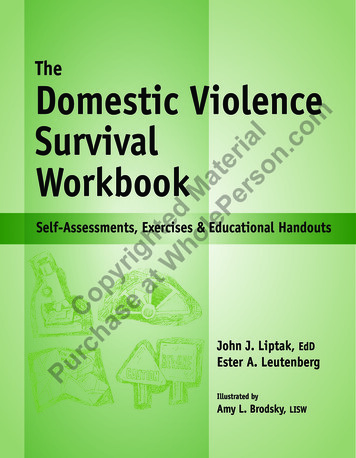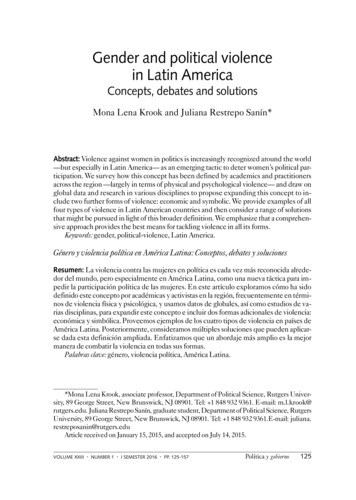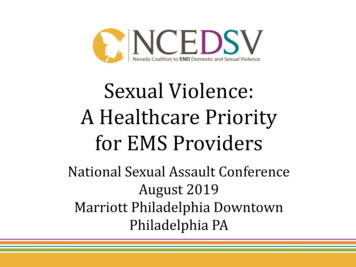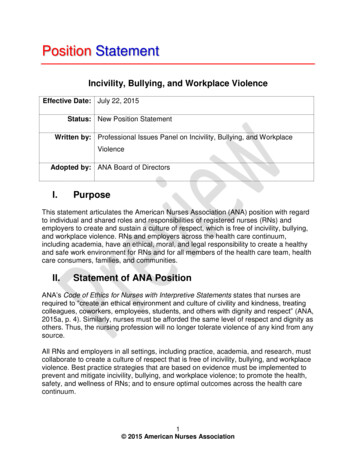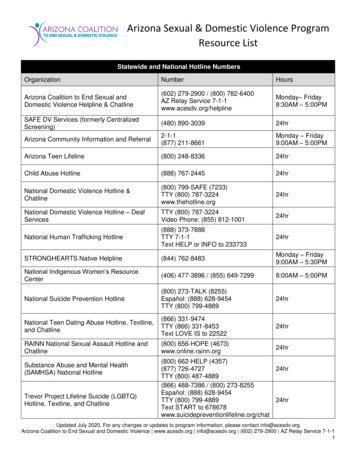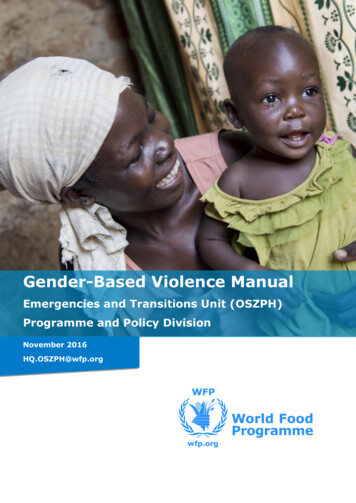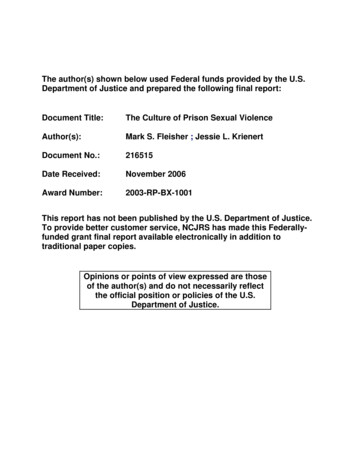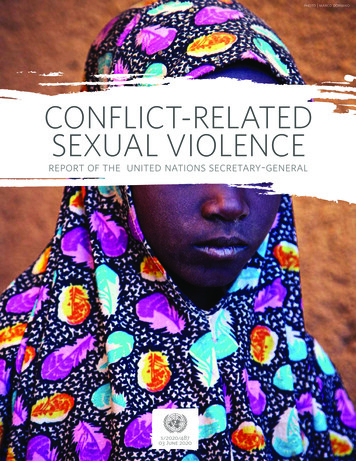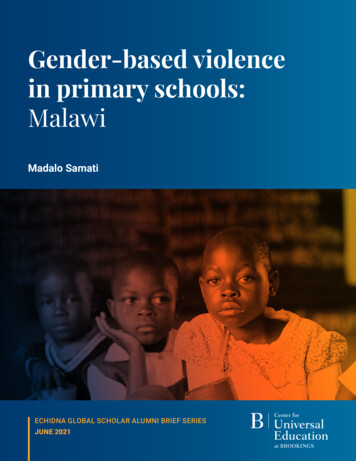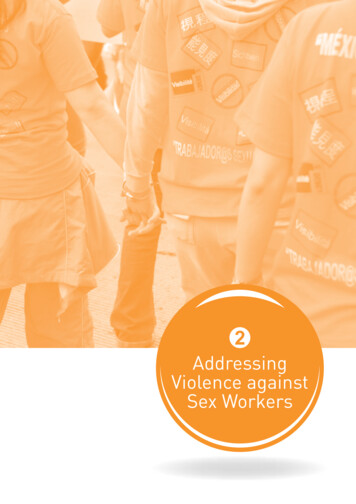
Transcription
2AddressingViolence againstSex Workers
2 Addressing Violence against Sex Workers2Starting, managing,monitoring and scalingup a programme—from both a centralized andcommunity perspectiveAddressingViolence againstSex WorkersCommunitymobilizationand structuralinterventions6ProgrammeManagement vices1CommunityEmpowerment54Clinical andSupportServicesCondom andLubricantProgrammingFundamental prevention,care and treatmentinterventions20
2 Addressing Violence against Sex WorkersWhat’s in this chapter?This chapter explains: the different kinds of violence that sex workers may experience, and how violence increasesvulnerability to HIV (Section 2.1) the places and contexts in which violence occurs, and the social and legal conditions that makesex workers vulnerable to violence and other human-rights violations (Section 2.1.1) core values and principles for effective programmes to address violence against sex workers(Section 2.1.2) promising interventions and strategies to address violence (Section 2.2) approaches to monitoring and evaluation of interventions (Section 2.3).The chapter also provides a list of resources and further reading (Section 2.4).21
2 Addressing Violence against Sex Workers2.1 Introduction2012 Recommendations:1 Good-practice RecommendationsFemale, male and transgender sex workers face high levels of violence, stigma, discrimination andother human-rights violations. Violence against sex workers is associated with inconsistent condomuse or lack of condom use, and with increased risk of STI and HIV infection. Violence also preventssex workers from accessing HIV information and services.Violence is defined by the World Health Organization (WHO) as the intentional use of physical forceor power, threatened or actual, against oneself, another person, or against a group or communitythat results or has a high likelihood of resulting in injury, death, sexual or psychological harm, maldevelopment or deprivation of liberty (see also Box 2.1).Male, female and transgender sex workers may face violence because of the stigma associated withsex work, which in most settings is criminalized, or due to discrimination based on gender, race, HIVstatus, drug use or other factors. Most violence against sex workers is a manifestation of genderinequality and discrimination directed at women, or at men and transgender individuals who do notconform to gender and heterosexual norms, either because of their feminine appearance or the waythey express their sexuality.Modelling estimates in two different epidemic contexts (Kenya and Ukraine) show that a reduction ofapproximately 25% in HIV infections among sex workers may be achieved when physical or sexualviolence is reduced.2 More HIV prevention programmes are implementing strategies to addressviolence against sex workers and protect their human rights as an integral part of HIV prevention,treatment and care. Addressing violence can make it easier for sex workers to access services andmake their own choices about their long-term health and welfare.1 Prevention and treatment of HIV and other sexually transmitted infections for sex workers in low- and middle-income countries: recommendations for a public health approach.WHO, UNFPA, UNAIDS, NSWP, 2012.2 See Decker et al (Section 2.4, Further reading No. 3).22
2 Addressing Violence against Sex WorkersThis chapter provides practical suggestions for HIV programme managers on how to implementstrategies that address violence. It builds on the 2012 Recommendations and the values andpreferences survey,3 in which sex workers highlighted the role of violence, criminalization and otherhuman-rights abuses in compromising their access to HIV and STI services.Box 2.1Forms of violence faced by sex workersPhysical violence: Being subjected to physical force which can potentially cause death, injury or harm. Itincludes, but is not limited to: having an object thrown at one, being slapped, pushed, shoved, hit with thefist or with something else that could hurt, being kicked, dragged, beaten up, choked, deliberately burnt,threatened with a weapon or having a weapon used against one (e.g. gun, knife or other weapon). Theseacts are operationally defined and validated in WHO survey methods on violence against women. Otheracts that could be included in a definition of physical violence are: biting, shaking, poking, hair-pulling andphysically restraining a person.Sexual violence: Rape, gang rape (i.e. by more than one person), sexual harassment, being physically forcedor psychologically intimidated to engage in sex or subjected to sex acts against one’s will (e.g. undesiredtouching, oral, anal or vaginal penetration with penis or with an object) or that one finds degrading orhumiliating.Emotional or psychological violence: Includes, but is not limited to, being insulted (e.g. called derogatorynames) or made to feel bad about oneself; being humiliated or belittled in front of other people; beingthreatened with loss of custody of one’s children; being confined or isolated from family or friends; beingthreatened with harm to oneself or someone one cares about; repeated shouting, inducing fear throughintimidating words or gestures; controlling behaviour; and the destruction of possessions.Human-rights violations that should be considered in conjunction with violence against sex workers are: having money extorted being denied or refused food or other basic necessities being refused or cheated of salary, payment or money that is due to the person being forced to consume drugs or alcohol being arbitrarily stopped, subjected to invasive body searches or detained by police being arbitrarily detained or incarcerated in police stations, detention centres and rehabilitation centreswithout due process being arrested or threatened with arrest for carrying condoms being refused or denied health-care services being subjected to coercive health procedures such as forced STI and HIV testing, sterilization, abortions being publicly shamed or degraded (e.g. stripped, chained, spat upon, put behind bars) being deprived of sleep by force.3 A global consultation conducted with sex workers by NSWP as part of the process of developing the 2012 Recommendations.23
2 Addressing Violence against Sex Workers2.1.1 Contexts of violenceThere are several contexts, dynamics and factors that put sex workers at risk for violence.Understanding them is key to designing appropriate programmatic responses. Workplace violence: This may include violence from managers, support staff, clients or co-workersin establishments where sex work takes place (e.g. brothels, bars, hotels). Violence from intimate partners and family members: Stigmatization of sex work may leadpartners or family members to think it acceptable to use violence to “punish” a woman who hassex with other men. It may be difficult for sex workers to leave an abusive relationship, particularlywhen perpetrators threaten them, or have control due to ownership of a home, or the power toharm or refuse access to their children. Violence by perpetrators at large or in public spaces: In most contexts, the antagonisticrelationship with police creates a climate of impunity for crimes against sex workers that maylead them to be the targets of violence or of other crimes that may turn violent, such as theft.Some perpetrators specifically target sex workers to “punish” them in the name of upholdingsocial morals, or to scapegoat them for societal problems, including HIV. Sex workers may alsoface violence from individuals in a position of power, e.g. nongovernmental organization (NGO)employers, health-care providers, bankers or landlords. Organized non-state violence: Sex workers may face violence from extortion groups, militias,religious extremists or “rescue” groups. State violence: Sex workers may face violence from military personnel, border guards andprison guards, and most commonly from the police. Criminalization or punitive laws against sexwork may provide cover for violence. Violence by representatives of the state compromises sexworkers’ access to justice and police protection, and sends a message that such violence is notonly acceptable but socially desirable.Laws and policies, including ones that criminalize sex work, may increase sex workers’ vulnerabilityto violence. For example, forced rescue and rehabilitation raids by the police in the context of antitrafficking laws may result in sex workers being evicted from their residences onto the streets,where they may be more exposed to violence. Fear of arrest or harassment by the police may forcestreet-based sex workers to move to locations that are less visible or secure, or pressure them intohurried negotiations with clients that may compromise their ability to assess risks to their own safety.Violence against sex workers is not always defined or perceived as a criminal act. For example, lawsmay not recognize rape against transgender individuals as a crime, or police may refuse to registera report of sexual violence made by a sex worker. Sex workers are often reluctant to report violentincidents to the police for fear of police retribution or of being prosecuted for engaging in sex work.Laws and policies that discriminate against transgender individuals and men who have sex with menincrease the vulnerability of male and transgender sex workers to abuse. Laws criminalizing HIVexposure may prevent HIV-positive sex workers from seeking support in cases of sexual violence, forfear of being prosecuted. Even where sex work is not criminalized, the application of administrativelaw, religious law or executive orders may be used by police officers to stop, search and detain sexworkers. This creates conditions in which sex workers face an increased likelihood of violence.Sex workers may also be made more vulnerable to violence through their working conditions orby compromised access to services. Some may have little control over the conditions of sexualtransactions (e.g. fees, clients, types of sexual services) if these are determined by a manager.24
2 Addressing Violence against Sex WorkersThe availability of drugs and alcohol in sex work establishments increases the likelihood of peoplebecoming violent towards sex workers working there. Sex workers who consume alcohol or drugsmay not be able to assess situations that are not safe for them.Violence or fear of violence may prevent sex workers from accessing harm reduction, HIV prevention,treatment and care, health and other social services as well as services aimed at preventing andresponding to violence (e.g. legal, health). Discrimination against sex workers in shelters for thosewho experience violence may further compromise their safety.2.1.2 Values and principles for addressing violence against sex workersCore values Promote the full protection of sex workers’ human rights. This includes the rights to: nondiscrimination; security of person and privacy; recognition and equality before the law; due processof law and the highest attainable standard of health; employment, and just and favourable conditionsof employment; peaceful assembly and association; freedom from arbitrary arrest and detention,and from cruel and inhumane treatment; and protection from violence. Reject interventions based on the notion of rescue and rehabilitation. Even when ostensiblyfocused on minors (who are not sex workers), such raids deprive sex workers of their agency(the choice, control and power to act for themselves) and increase the likelihood that they willexperience violence. Promote gender equality by encouraging programme planners and implementers to challengeunequal gender roles, social norms and distribution and control of resources and power. Interventionstrategies should aim for more equitable power relationships between sex workers and others inthe wider community. Respect the right of sex workers to make informed choices about their lives, which may involvenot reporting or seeking redress for violence, not seeking violence-related services, or continuingin an abusive relationship.Programming principles Gather information about local patterns of violence against sex workers, and the relationshipof violence to HIV, as the basis for designing programmes (see Chapter 3, Section 3.2.2, part A). Use participatory methods. Sex workers should be in decision-making positions where they canengage in processes to identify their problems and priorities, analyse causes and develop solutions.Such methods strengthen programme relevance, build enduring life and relationship skills and helpensure the long-term success of programmes. Use an integrated approach in designing interventions. Holistic programmes that includeprovision of health services, work with the legal and justice sectors and are community-based4can have a greater impact on violence against sex workers and the risk of HIV. Such programmesrequire establishing partnerships with a wide range of groups and institutions. Build capacity of programme staff to understand and address the links between violence againstsex workers and HIV. Programme staff should be able to respond sensitively to sex workers whoexperience violence, without further stigmatizing or blaming them. (See also Chapter 6, Section6.2.6, sub-section on hiring and training staff.)4 In most contexts in this tool, “community” refers to populations of sex workers rather than the broader geographic, social or cultural groupings of which they maybe a part. Thus, “outreach to the community” means outreach to sex workers, “community-led interventions” are interventions led by sex workers, and “communitymembers” are sex workers.25
2 Addressing Violence against Sex Workers Recognize that programmes may have unintended harmful impacts for sex workers, such asretaliatory or “backlash” violence. Prepare for this possibility and monitor programmes for suchunintended cons
Starting, managing, monitoring and scaling up a programme— from both a centralized and community perspective 5 Clinical and Support Services 4 Condom and Lubricant Programming 3 Community-led Services 6 Programme Management and Organizational Capacity-building 1 Community Empowerment 20 Community mobilization and structural interventions 2 Addressing Violence against Sex Workers. 2
